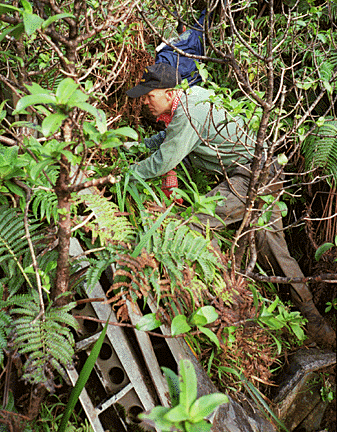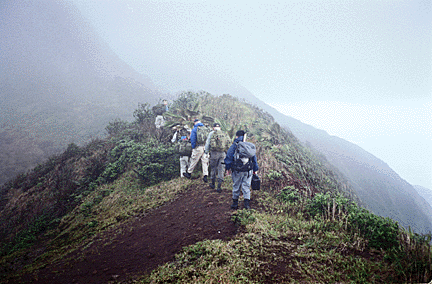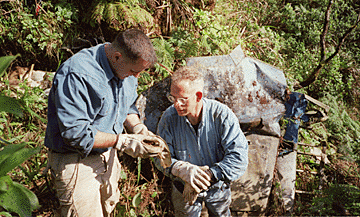

A 1944 Mystery is Solved

Finding
Ensign Warnke
A team has recovered his
By Gregg K. Kakesako
crashed F-6F Hellcat 55 years
after he disappeared
Star-BulletinAt 7:55 a.m. June 15, 1944, Navy Ensign Harry Warnke took off from Barbers Point Naval Air Station in an F-6F Hellcat fighter on a routine training flight.
Warnke, 23, who had enlisted in the Navy after attending college in his hometown of Gary, Ind., never completed the mission.
For years Warnke's family believed he had crashed into the Pacific Ocean, and a headstone was erected over an empty grave at the family plot in Westville, a small farming community in northern Indiana.

After 55 years, a nine-member team from Camp Smith's Joint Task Force Full Accounting last week recovered the wreck of his Hellcat in a deep ravine on the Kaneohe side of the Koolaus, and attempts are under way to try to find his remains."It's sort of a final thing if they find him," said Warnke's sister, Myrtle Tice, of Green Valley, Ariz.
"If they recover anything, I would be willing to pay to have him shipped here," she told the Star-Bulletin in a phone interview. "My father put up a headstone for him in Westville. That's where his family is from and that is where he retired to farm."
When Warnke left Barbers Point in his single-seat fighter, all of the peaks of the Koolaus were covered by moderate overcast.
Warnke was part of an eight-plane flight that had qualified several days earlier in daylight carrier landings aboard the USS Benjamin Franklin. Warnke's squadron -- the Fighting Twenty -- was composed of 36 Hellcats.
Their mission that morning in June 55 years ago was to make dive-bombing and rocket runs on a truck at Kapaho Point, just south of what was then Kaneohe Naval Air Station.
Warnke had made four successful dives.
After the fourth run, he failed to make a rendezvous with his flight leader, Lt. J.D. Petersen, and was reported missing.
Two days later, a shoe was found on a Koolau mountaintop. The only thing visible then, according to one witness who hiked to the crash site, was a "piece of the tail." The pilot's remains were believed to have been buried near the wreckage, but the site was never marked.
That is until 1994, when the Army Central Identification Laboratory was asked by Sen. John McCain to recover Warnke's remains.
Tice, 79, said she wrote to McCain only because she wanted to know what happened to her brother.
"All my mother knew was what the Navy had told her and that was the plane went into the sea."
It was McCain's office that finally set the record straight nearly five years ago.
On Feb. 11 a team from Joint Task Force Full Accounting, on a training mission and based on data from the Army Central Identification Lab, spotted the wreckage on the rugged slopes of the Koolaus far above the H-3 freeway.
Tice has made several trips to Hawaii. One of the trips was to ensure that her brother's name is enshrined on the walls of the National Cemetery of the Pacific.
Although she has never met McCain, she is grateful that the Arizona senator was willing to take up her case.
"I am going to have to write to him," she said shortly after a military casualty officer informed her of the find.
The F6-F Hellcat
First flew: June 1942
Total kills in WWII: 5,156 aircraft
Maximum speed: 380 mph
Length: 33 feet
Wingspan: 42 feet
Range: 945 miles
Armament: Six .50-caliber machine guns, 3,000 pounds of bombs or rockets

From the Koolaus
to Southeast Asia
The mission: Account for the
By Gregg K. Kakesako
missing and bring closure
to families
Star-BulletinSurveying a remote crash site for a World War II fighter more than 2,600 feet in the Koolaus is a far cry from operating in the jungles of Southeast Asia.
But nine members of Joint Task-Force Full Accounting took on the assignment as real-world training to prepare themselves to investigate and help recover remains of servicemen killed in Vietnam, Laos and Cambodia.
The 160-member, multi-service Pacific Command Joint Task Force operation was created to account for U.S. servicemen killed in Vietnam, Laos and Cambodia. In 1973 at the close of the Vietnam War, 2,583 servicemen were missing. Since then that figure has been trimmed to 2,069.
Air Force Maj. Joe Davis, task force spokesman, said its mission is achieve the fullest accounting of Americans missing from the Southeast Asia war.
Numerous unsuccessful attempts had been made since 1994 to try to pinpoint the crash site of Navy Ensign Harry Warnke, who died when his Hellcat fighter smashed into the slopes of the Koolaus during a training mission more than a half-century ago.
As Army Sgt. 1st Class Patrick Franco, who has made 20 survey and recovery trips to Vietnam, pointed out after last week's operation: "It's been more than 50 years and it looks like the right case. This will help to bring closure to the family, and that is what I want in this case and all the others."
As with a Southeast Asia recovery mission, Army Maj. Ken Royalty, task force team leader, even interviewed witnesses such as Rear Adm. F.E. Bakutis, who in 1944 was commander of Fighting Squadron 20 -- Warnke's unit.
"The guy was pretty sharp," said Royalty, referring to the 86-year-old retired Navy officer. "He was dead on in pinpointing the location."
Bakutis, who holds the Navy Cross and during the Pacific War would become a double Navy ace by downing 12 Japanese fighters, had hiked into the Koolaus and reported that the plane had buried itself all the way to the tail. Only two feet of the tail was visible.
Royalty also credited previous efforts by the Army Central Identification Lab, which made last week's task easier.
"We relied on their documentation and earlier searches," Royalty said.
The first attempt by the task force team to reach the site by foot last Monday had to be called after 30 minutes since the helicopter landing zone on the ridge overlooking the H-3 freeway was covered with heavy clouds and rain.
Two days later the team would try again. This time only a slight early-morning haze greeted 25th Division UH-60 Black Hawk pilot Chief Warrant Officer Dan Baum. Just a few clouds topped the peaks of the Koolaus.
Below the Army helicopter, early-morning commuters lined up along the H-2 and H-3 freeways. A gentle crosswind buffeted the Black Hawk as Baum approached the summit.
Nearly 1,000 feet to the east lay the Hellcat crash site. But it would take nearly an hour of hiking along the muddy, sparsely vegetated -- but treacherous and rugged -- ridge line of the Koolaus before the team would reach the site located in a deep ravine.
The debris from Warnke's Hellcat was scattered on a slope, which Royalty estimated to be at an angle of at least 75 degrees. The first signs of the wreck were found about 500 feet from the summit. Most of the wreck was heavily embedded in the slope. The team estimated the crash site extended over an area 330 feet by 83 feet.
Army Sgt. 1st Class Patrick Franco, a linguist with the team, said the site survey was conducted exactly the way it would have been in Southeast Asia.
It was up to Army Sgt. 1st Class Al Iversen, who has made 18 Southeast Asia survey and recovery trips, to first determine the exact location by taking and recording ground position satellite readings.
The team lined up above the wreck and worked its way down using machetes to clear away the undergrowth. Small blue pin flags were used to mark various pieces of the wreck.
Repeatedly, team leader Royalty would remind his crew: "Boys, we are looking for pieces with numbers. I need part numbers. No one can argue with that."
Franco said: "The No. 1 priority would be to uncover any remains, personal effects, such as dog tags or wallets or ID cards. Then we would look for items from the wreck such as a helmet or an oxygen hose."
It would be his job to sketch a map of the area. Then all of the recovered parts would be photographed, while Royalty and Air Force Master Sgt. Hung M. Nguyen would videotape the area, pointing out key features and items recovered.
"Excavation would be left to CILHI (Central Identification Laboratory)," Royalty said.
Air Force Capt. Donald Hinton, Joint Task Force air operations officer, said it looked like the pilot approached the Koolaus from Kaneohe.
"It seems that it may have yanked on the stick, just barely clearly a ridge and ended up upside down," Hinton said.
The team was able to recover two propeller blades -- one that still had a legible decal, "Hamilton Standard Propellers. East Hartford, Connecticut."
Each blade weighed at least 90 pounds. Both were carried from the site by Marine Maj. Mike Johnson and Army Lt. Col. Jeffrey Buchanan for further study.
Two other pieces of the wreckage bore the numbers "82" -- Warnke's aircraft number. Also recovered was a part with F6-F inscribed, noting the type of aircraft -- a Hellcat; large pieces of the wing and two tires.
Although no remains were uncovered, Royalty was optimistic that when a team from the Central Identification Lab excavated the area it would be able to recover something.
"I won't rule it out," said Royalty. "I remember one site in Vietnam. You couldn't tell a plane had crashed there, but they were able to get out 90 pieces of bone fragments."
Joint Task Force
Full AccountingEstablished: Jan. 23, 1992
Mission: Account for the 2,267 servicemen still missing in Southeast Asia from the Vietnam War
Staff: 160 linguists, analysts and other specialities from all military services
Headquarters: Camp Smith
Operations: 2,870 investigations, 477 recovery operations, repatriation of 465 sets of remains
Search areas: Vietnam, Laos, Cambodia